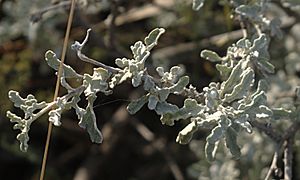Parthenium incanum facts for kids
Quick facts for kids Mariola |
|
|---|---|
 |
|
| Parthenium incanum growing in Walnut Canyon at Carlsbad Caverns National Park, New Mexico | |
| Scientific classification | |
| Kingdom: | |
| (unranked): | |
| (unranked): | |
| (unranked): | |
| Order: | |
| Family: | |
| Tribe: | |
| Genus: |
Parthenium
|
| Species: |
P. incanum
|
| Binomial name | |
| Parthenium incanum Kunth
|
|
Mariola, also known as the New Mexico rubber plant, is a cool plant found in North America. Its scientific name is Parthenium incanum. It belongs to the Parthenium group of plants and is part of the Asteraceae family, which includes daisies and sunflowers.
This plant grows naturally in the Southwestern United States and different parts of Mexico. You can find it in dry places like desert grasslands, especially in the Chihuahuan Desert. It also grows on dry, rocky slopes and wide-open plains.
Contents
What Mariola Looks Like
Mariola plants usually grow to be about 1.5 to 3 feet (0.45 to 0.9 meters) tall and wide. They have a bushy shape.
Their leaves are a fuzzy, grayish-white color, which helps them survive in sunny, dry areas. Small white flowers grow in clusters on the plant. You can usually see these flowers from July to October.
How People Use Mariola
People have found several interesting ways to use the Mariola plant.
Traditional Medicine
The Jicarilla Apache people, a Native American tribe, used mariola as a traditional medicinal plant. They would boil the plant's leaves to make a special liquid. This liquid was then gently rubbed on a pregnant woman's stomach to help her feel more comfortable.
Gardening and Landscaping
Mariola is also grown as an ornamental plant because it looks nice. It's a great choice for drought-tolerant gardens, which means it doesn't need much water.
It's also popular in native plant gardens, where people grow plants that naturally belong in the area. Plus, it can be used in wildlife gardens to help local animals and insects.

